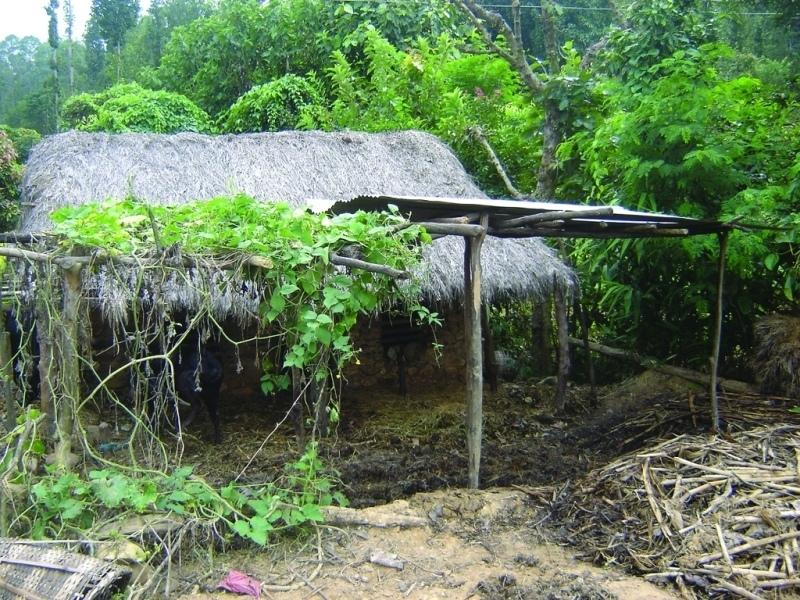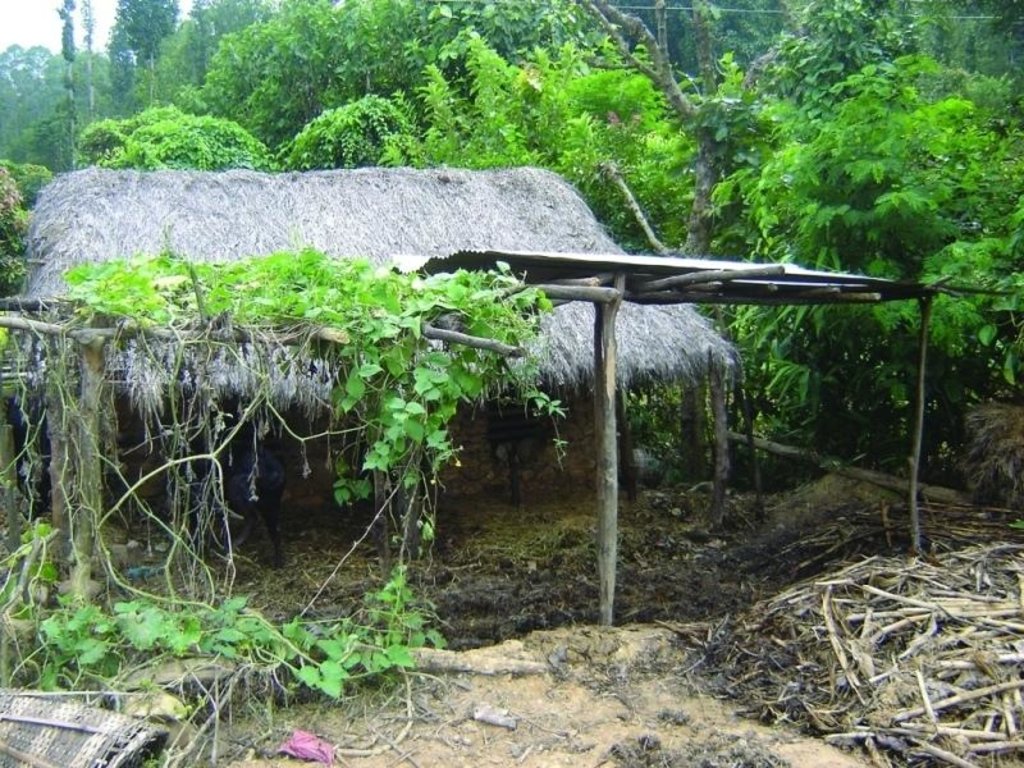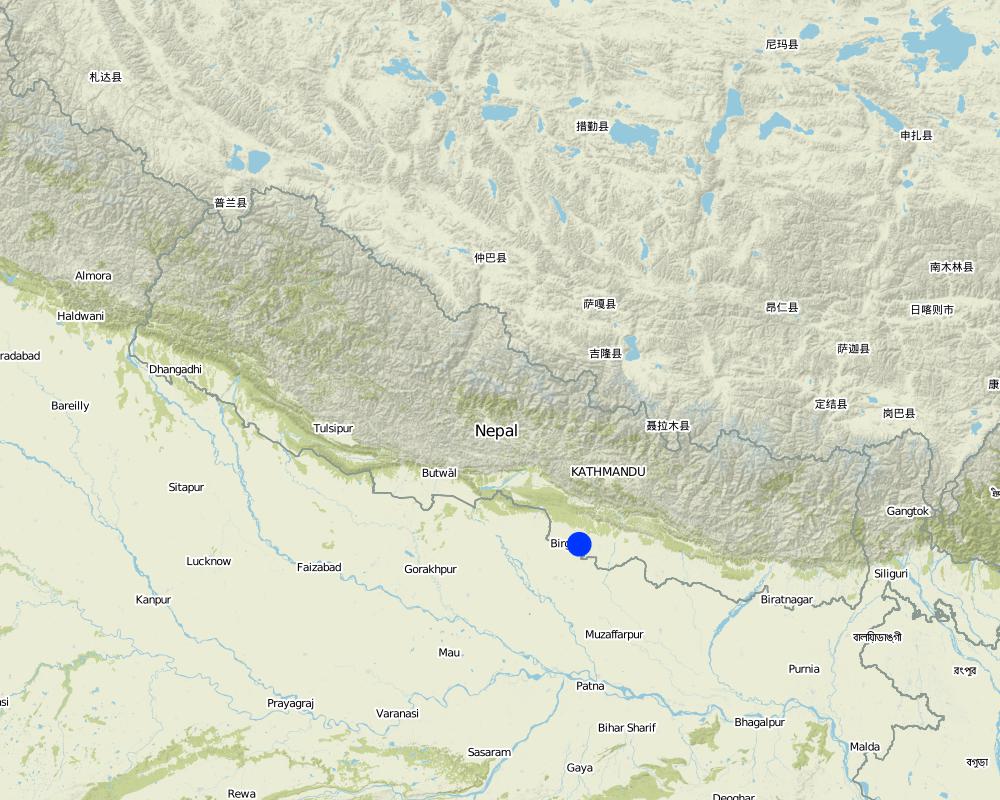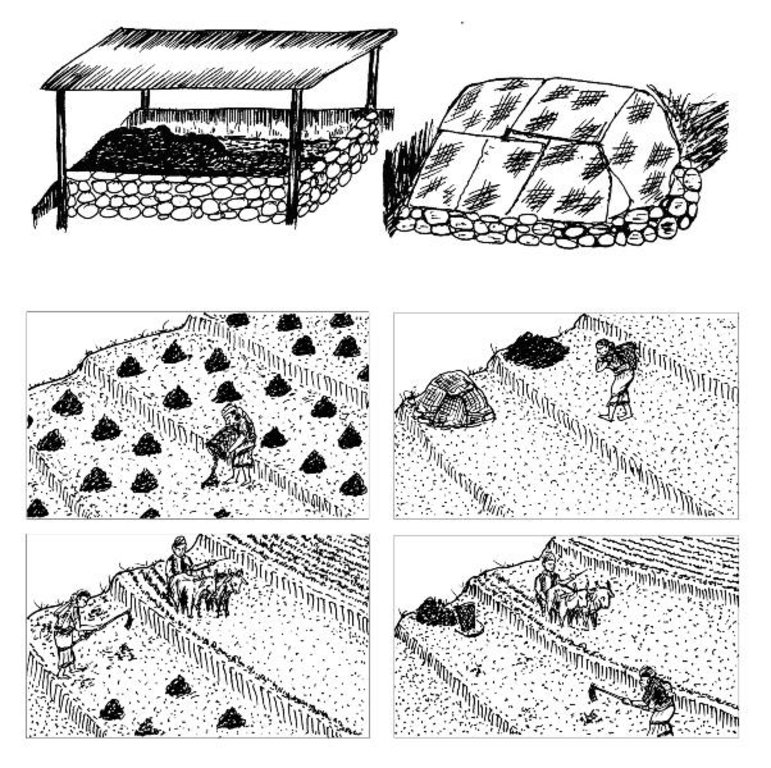Improved farmyard manure through sunlight, rain and runoff protection [เนปาล]
- ผู้สร้างสรรค์:
- การอัพเดท:
- ผู้รวบรวม: Richard Allen
- ผู้เรียบเรียง: –
- ผู้ตรวจสอบ: David Streiff, Alexandra Gavilano
Gham, bhalpani ra baleni bata bachai nirman gariyeko ramro gnastar ko gothemal (Nepali)
technologies_1756 - เนปาล
ดูส่วนย่อย
ขยายทั้งหมด ย่อทั้งหมด1. ข้อมูลทั่วไป
1.2 รายละเอียดที่ติดต่อได้ของผู้รวบรวมและองค์กรที่เกี่ยวข้องในการประเมินและการจัดเตรียมทำเอกสารของเทคโนโลยี
ผู้เชี่ยวชาญ SLM:
Director
Soil Management Directorate, Department of Agriculture
เนปาล
ผู้เชี่ยวชาญ SLM:
Team Leader
Sustainable Soil Management Programme
เนปาล
ชื่อของโครงการซึ่งอำนวยความสะดวกในการทำเอกสารหรือการประเมินเทคโนโลยี (ถ้าเกี่ยวข้อง)
Sustainable Soil Management Programme, Nepal (SSMP)ชื่อขององค์กรซึ่งอำนวยความสะดวกในการทำเอกสารหรือการประเมินเทคโนโลยี (ถ้าเกี่ยวข้อง)
Department of Agriculture, Soil Management Directorate, Hariharbhawan Lalitpur (doasoil) - เนปาลชื่อขององค์กรซึ่งอำนวยความสะดวกในการทำเอกสารหรือการประเมินเทคโนโลยี (ถ้าเกี่ยวข้อง)
HELVETAS (Swiss Intercooperation)1.3 เงื่อนไขการใช้ข้อมูลที่ได้บันทึกผ่านทาง WOCAT
ผู้รวบรวมและวิทยากรหลักยอมรับเงื่อนไขเกี่ยวกับการใช้ข้อมูลที่ถูกบันทึกผ่านทาง WOCAT:
ใช่
1.5 Reference to Questionnaire(s) on SLM Approaches (documented using WOCAT)

Farmer field schools on integrated plant nutrient systems [เนปาล]
Participatory and collaborative learning through the farmer field school approach
- ผู้รวบรวม: Richard Allen

Farmer-to-farmer diffusion [เนปาล]
Wider diffusion of sustainable soil management technologies through a demand responsive farmer-to-farmer diffusion approach
- ผู้รวบรวม: Richard Allen
2. การอธิบายลักษณะของเทคโนโลยี SLM
2.1 การอธิบายแบบสั้น ๆ ของเทคโนโลยี
คำจำกัดความของเทคโนโลยี:
Improving farmyard manure by protecting it from direct sunlight, rainfall, and runoff to reduce volatilisation and leaching
2.2 การอธิบายแบบละเอียดของเทคโนโลยี
คำอธิบาย:
Farmyard manure is the most common form of organic fertiliser applied to crops in the midhills of Nepal. Farmyard manure has a high proportion of organic material which nurtures soil organisms and is essential for maintaining an active soil life. Typically, only about half of the nutrient content of farmyard manure becomes available for crop growth during the first year after it is applied to the soil. The rest of the nutrients are channelled through soil biotic processes and are released in the following years. The high organic matter content and the more active soil life improve or maintain a friable soil structure, increase the cation exchange capacity, the water holding capacity, and the infiltration rate, and reducing the risk of soil pests.
Indigenous methods of preparing and using farmyard manure vary depending on the ecological zone, access to bedding material from crop or forest land and to crop residues and fodder, the availability of labour, and other factors. Traditionally, Nepali farmers take the manure out of their sheds to dry it for 2-3 days and then carry it to the field where it is left in small heaps for a number of days before being spread and incorporated into the soil.
Farmers rate the quality of manure according to which livestock species it comes from. These ratings have been confirmed by nutrient analysis as cattle manure (NPK%: 0.6, 0.13, 0.66) is considered to be better than buffalo manure (0.33, 0.25, 0.10), and horse manure; while pig (0.5, 0.18, 0.42), goat (0.6, 0.13, 0.99), and sheep manure (0.6, 0.13, 0.99) are considered better than cattle manure. Chicken manure (1.46, 0.51, 0.51) is considered the best of all.
It has however been shown that considerable nutrient losses occur if the manure is inappropriately handled or stored. Drying of the manure leads to loss of nutrients through volatilisation, and rainfall and runoff leads to leaching or washing out of nutrients. In addition, the common disposal of urine - the part of the excreta with the highest nutrient concentration - further reduces the level of nutrients in manure.
To reduce nutrient losses farmyard manure needs to be protected from direct sunlight; protected from rainfall or run-on; and protected from runoff. This can be achieved in a variety of ways using a variety of inputs. It is most important to protect the manure during storage and just before it is applied in the field to make the best use of this valuable local resource.
2.3 รูปภาพของเทคโนโลยี
2.5 ประเทศภูมิภาค หรือสถานที่ตั้งที่เทคโนโลยีได้นำไปใช้และได้รับการครอบคลุมโดยการประเมินนี้
ประเทศ:
เนปาล
ข้อมูลจำเพาะเพิ่มเติมของสถานที่ตั้ง :
Midhills districts of Nepal
ระบุการกระจายตัวของเทคโนโลยี:
- ใช้ ณ จุดที่เฉพาะเจาะจงหรือเน้นไปยังบริเวณพื้นที่ขนาดเล็ก
Map
×3. การจัดประเภทของเทคโนโลยี SLM
3.1 วัตถุประสงค์หลักของเทคโนโลยี
- Improve manure
3.2 ประเภทของการใช้ที่ดินในปัจจุบันที่ได้นำเทคโนโลยีไปใช้

พื้นที่ปลูกพืช
- การปลูกพืชล้มลุกอายุปีเดียว
แสดงความคิดเห็น:
Major land use problems (compiler’s opinion): Intensifying cultivation practices with either 1) inadequate application of fertilisers leading to a decline in soil fertility and the mining of soil nutrients or 2) application of too much fertiliser causing environmental problems through excessive leaching, and losses of fertiliser in surface runoff and consequent eutrophication or nitrification of streams, ponds or groundwater
3.5 กลุ่ม SLM ที่ตรงกับเทคโนโลยีนี้
- การจัดการความอุดมสมบรูณ์ของดินแบบผสมผสาน
3.6 มาตรการ SLM ที่ประกอบกันเป็นเทคโนโลยี

มาตรการอนุรักษ์ด้วยการจัดการ
- M2: การเปลี่ยนแปลงของการจัดการหรือระดับความเข้มข้น
3.7 รูปแบบหลักของการเสื่อมโทรมของที่ดินที่ได้รับการแก้ไขโดยเทคโนโลยี

การเสื่อมโทรมของดินทางด้านเคมี
- Cn (Fertility decline): ความอุดมสมบูรณ์และปริมาณอินทรียวัตถุในดินถูกทำให้ลดลงไป (ไม่ได้เกิดจากสาเหตุการกัดกร่อน)
3.8 การป้องกัน การลดลง หรือการฟื้นฟูความเสื่อมโทรมของที่ดิน
ระบุเป้าหมายของเทคโนโลยีกับความเสื่อมโทรมของที่ดิน:
- ลดความเสื่อมโทรมของดิน
4. ข้อมูลจำเพาะด้านเทคนิค กิจกรรมการนำไปปฏิบัติใช้ ปัจจัยนำเข้า และค่าใช้จ่าย
4.1 แบบแปลนทางเทคนิคของเทคโนโลยี
ข้อมูลจำเพาะด้านเทคนิค (แบบแปลนทางเทคนิคของเทคโนโลยี):
a) Covering the farmyard manure with a roof made of tin sheet or plastic sheets. Cheaper alternatives are:
- a thatched roof
- shading with creepers like cucurbits
- planting broadleaf mustard on the heap
- applying a covering of crop residues or forest material
b) Farmyard manure is traditionally carried to the fi elds in doko baskets and left there in unprotected heaps to be incorporated often weeks and sometimes several months later (top and bottom left). It is much better to incorporate it on the day of transport as the longer it is left out on the fi elds in heaps the greater are the nutrient losses from the heaps (bottom right). Alternatively it can be stored in a corner of the fi eld covered with plastic sheets, crop residues, or in some other way (top right).
Technical knowledge required for field staff / advisors: low
Technical knowledge required for land users: low
Main technical functions: increase in organic matter, increase in soil fertility, increase in soil productivity
Secondary technical functions: increased infiltration rate and water holding capacity, improved soil physical properties (friability,easier soil preparation)
Layout change according to natural and human environment: protect farmyard manure; change application
4.2 ข้อมูลทั่วไปเกี่ยวกับการคำนวณปัจจัยนำเข้าและค่าใช้จ่าย
ระบุสกุลเงินที่ใช้คำนวณค่าใช้จ่าย:
- USD
ระบุค่าเฉลี่ยของค่าจ้างในการจ้างแรงงานต่อวัน:
2.00
4.3 กิจกรรมเพื่อการจัดตั้ง
| กิจกรรม | Timing (season) | |
|---|---|---|
| 1. | Cover the farmyard manure heap or pit with any available material (crop residues, forest material, plastic sheet, thatched roof, zinc sheet, etc.) |
4.4 ค่าใช้จ่ายของปัจจัยนำเข้าที่จำเป็นสำหรับการจัดตั้ง
| ปัจจัยนำเข้า | หน่วย | ปริมาณ | ค่าใช้จ่ายต่อหน่วย | ค่าใช้จ่ายทั้งหมดต่อปัจจัยนำเข้า | %ของค่าใช้จ่ายที่ก่อให้เกิดขึ้นโดยผู้ใช้ที่ดิน | |
|---|---|---|---|---|---|---|
| แรงงาน | Building manure pit and shelter | Persons/day | 1.0 | 2.0 | 2.0 | 100.0 |
| วัสดุสำหรับก่อสร้าง | Material | unit | 1.0 | 25.0 | 25.0 | 100.0 |
| ค่าใช้จ่ายทั้งหมดของการจัดตั้งเทคโนโลยี | 27.0 | |||||
| Total costs for establishment of the Technology in USD | 27.0 | |||||
4.5 การบำรุงรักษาสภาพหรือกิจกรรมที่เกิดขึ้นเป็นประจำ
| กิจกรรม | ช่วงระยะเวลา/ความถี่ | |
|---|---|---|
| 1. | Pour household wastewater onto the heap or pit to keep the farmyard |
4.6 ค่าใช้จ่ายของปัจจัยนำเข้าและกิจกรรมที่เกิดขึ้นเป็นประจำที่ต้องการการบำรุงรักษา (ต่อปี)
แสดงความคิดเห็น:
Cost as in January 2007
5. สิ่งแวดล้อมทางธรรมชาติและของมนุษย์
5.1 ภูมิอากาศ
ฝนประจำปี
- < 250 ม.ม.
- 251-500 ม.ม.
- 501-750 ม.ม.
- 751-1,000 ม.ม.
- 1,001-1,500 ม.ม.
- 1,501-2,000 ม.ม.
- 2,001-3,000 ม.ม.
- 3,001-4,000 ม.ม.
- > 4,000 ม.ม.
ข้อมูลจำเพาะ/ความคิดเห็นเรื่องปริมาณน้ำฝน:
Annual rainfall: Also 2000-3000 mm
เขตภูมิอากาศเกษตร
- ชื้น
Thermal climate class: subtropics
5.2 สภาพภูมิประเทศ
ค่าเฉลี่ยความลาดชัน:
- ราบเรียบ (0-2%)
- ลาดที่ไม่ชัน (3-5%)
- ปานกลาง (6-10%)
- เป็นลูกคลื่น (11-15%)
- เป็นเนิน (16-30%)
- ชัน (31-60%)
- ชันมาก (>60%)
ธรณีสัณฐาน:
- ที่ราบสูง/ที่ราบ
- สันเขา
- ไหล่เขา
- ไหล่เนินเขา
- ตีนเนิน
- หุบเขา
ระดับความสูง:
- 0-100 เมตร
- 101-500 เมตร
- 501-1,000 เมตร
- 1,001-1,500 เมตร
- 1,501-2,000 เมตร
- 2,001-2,500 เมตร
- 2,501-3,000 เมตร
- 3,001-4,000 เมตร
- > 4,000 เมตร
ความคิดเห็นและข้อมูลจำเพาะเพิ่มเติมเรื่องสภาพภูมิประเทศ:
Slopes on average: Also moderate (6-10%), rolling (11-15%) and hilly (16-30%)
Landforms: Also footslopes
Altitudinal zone: Also 1000-1500 m a.s.l., 1500-2000 m a.s.l. and 2000-2500 m a.s.l.
5.6 ลักษณะของผู้ใช้ที่ดินที่นำเทคโนโลยีไปปฏิบัติใช้
แนวทางการตลาดของระบบการผลิต:
- เพื่อการยังชีพ (หาเลี้ยงตนเอง)
- mixed (subsistence/ commercial)
เป็นรายบุคคล/ครัวเรือน:
- เป็นรายบุคคล/ครัวเรือน
ระบุลักษณะอื่นๆที่เกี่ยวข้องของผู้ใช้ที่ดิน:
Off-farm income specification: In most farm households, off-farm income plays at least a minor and increasingly a major role. Occasional opportunities for off-farm income present themselves in the form of daily labour wages. Some households’ members receive regular salaries, whilst an increasing number of Nepalis are working in India, the Middle East, Malaysia, and elsewhere and sending remittance incomes home.
Market orientation of production system: Also commercial/ market
5.7 Average area of land used by land users applying the Technology
- < 0.5 เฮกตาร์
- 0.5-1 เฮกตาร์
- 1-2 เฮกตาร์
- 2-5 เฮกตาร์
- 5-15 เฮกตาร์
- 15-50 เฮกตาร์
- 50-100 เฮกตาร์
- 100-500 เฮกตาร์
- 500-1,000 เฮกตาร์
- 1,000-10,000 เฮกตาร์
- >10,000 เฮกตาร์
5.8 กรรมสิทธิ์ในที่ดิน สิทธิในการใช้ที่ดินและสิทธิในการใช้น้ำ
กรรมสิทธิ์ในที่ดิน:
- รายบุคคล ไม่ได้รับสิทธิครอบครอง
- รายบุคคล ได้รับสิทธิครอบครอง
สิทธิในการใช้ที่ดิน:
- เช่า
- รายบุคคล
แสดงความคิดเห็น:
Sharecropping between owner and tenant
6. ผลกระทบและสรุปคำบอกกล่าว
6.1 ผลกระทบในพื้นที่ดำเนินการ (On-site) จากการใช้เทคโนโลยี
ผลกระทบทางด้านเศรษฐกิจและสังคม
การผลิต
การผลิตพืชผล
รายได้และค่าใช้จ่าย
ค่าใช่จ่ายของปัจจัยการผลิตทางการเกษตร
แสดงความคิดเห็น/ระบุ:
Reduced expenditure on mineral fertilisers
ผลกระทบด้านนิเวศวิทยา
ผลกระทบด้านนิเวศวิทยาอื่น ๆ
Soil characteristics
6.2 ผลกระทบนอกพื้นที่ดำเนินการ (Off-site) จากการใช้เทคโนโลยี
การเกิดมลพิษในน้ำบาดาลหรือแม่น้ำ
แสดงความคิดเห็น/ระบุ:
Reduction of nutrient influx into water bodies
Dependence on outside inputs
6.4 การวิเคราะห์ค่าใช้จ่ายและผลประโยชน์ที่ได้รับ
ผลประโยชน์ที่ได้รับเปรียบเทียบกับค่าใช้จ่ายในการจัดตั้งเป็นอย่างไร (จากมุมมองของผู้ใช้ที่ดิน)
ผลตอบแทนระยะสั้น:
ด้านบวก
ผลตอบแทนระยะยาว:
ด้านบวก
ผลประโยชน์ที่ได้รับเปรียบเทียบกับค่าใช้จ่ายในการบำรุงรักษาหรือต้นทุนที่เกิดขึ้นซ้ำอีก เป็นอย่างไร (จากมุมมองของผู้ใช้ที่ดิน)
ผลตอบแทนระยะสั้น:
ด้านบวก
ผลตอบแทนระยะยาว:
ด้านบวก
แสดงความคิดเห็น:
Large short- and long-term benefits due to need to use less of the costly mineral fertilisers. The only extra ‘cost’ is the extra labor needed.
6.5 การปรับตัวของเทคโนโลยี
แสดงความคิดเห็น:
Comments on acceptance with external material support: An independent assessment found that 95% of the farmers participating in SSMP’s farmyard improvement activities were accepted the technology.
Comments on adoption trend: About 70% of non-participant farmers who had come into contact with the technologies had also adopted them.
6.7 จุดแข็ง / ข้อได้เปรียบ / โอกาสของเทคโนโลยี
| จุดแข็ง / ข้อได้เปรียบ / โอกาสในทัศนคติของผู้รวบรวมหรือวิทยากรหลัก |
|---|
|
The use of improved farmyard manure reduced the need for mineral fertiliser thereby reducing production costs and outside dependency How can they be sustained / enhanced? Further promotion of the technology will increase this impact |
| A simple technology affordable by poor farmers in remote areas far from a roadhead |
| The increased use of organic fertiliser improves the physical characteristics of soil making ploughing easier and increasing water holding capacity of the soil |
6.8 จุดอ่อน / ข้อเสียเปรียบ / ความเสี่ยงของเทคโนโลยีและวิธีการแก้ไข
| จุดอ่อน / ข้อเสียเปรียบ / ความเสี่ยงในทัศนคติของผู้รวบรวมหรือวิทยากรหลัก | มีวิธีการแก้ไขได้อย่างไร |
|---|---|
| Cost of a permanent roof for the manure heap may hinder adoption of the technology | Promote simple alternatives to high cost roofs such as straw cover, cover with broad leaf mustard, thatch, and waste plastic |
7. การอ้างอิงและการเชื่อมต่อ
7.1 วิธีการและแหล่งข้อมูล
7.2 การอ้างอิงถึงสิ่งตีพิมพ์
หัวข้อ, ผู้เขียน, ปี, หมายเลข ISBN:
STSS; SSMP (2001) Farmyard Manure and Compost Management (in Nepali) Kathmandu: Soil Testing Services Section, Department of Agriculture and Sustainable Soil Management Programme
ชื่อเรื่อง ผู้เขียน ปี ISBN:
SSMP
ลิงก์และโมดูล
ขยายทั้งหมด ย่อทั้งหมดลิงก์

Farmer field schools on integrated plant nutrient systems [เนปาล]
Participatory and collaborative learning through the farmer field school approach
- ผู้รวบรวม: Richard Allen

Farmer-to-farmer diffusion [เนปาล]
Wider diffusion of sustainable soil management technologies through a demand responsive farmer-to-farmer diffusion approach
- ผู้รวบรวม: Richard Allen
โมดูล
ไม่มีโมดูล





